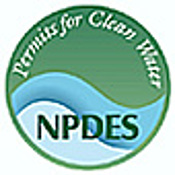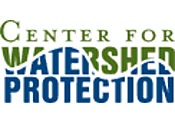Storm Water Management Information
Background
Stormwater runoff is generated from land surfaces and impervious areas such as paved streets, parking lots, and building rooftops during rainfall and snow events. Unfortunately, this runoff can contain pollutants in quantities that adversely affect water quality.
Stormwater pollution is caused by the daily activities of people everywhere. Rainwater and snowmelt run off streets, lawns, farms, and construction and industrial sites and pick up fertilizers, dirt, pesticides, oil and grease, and many other pollutants on the way to our rivers, lakes, and coastal waters. Stormwater runoff is our most common cause of water pollution. Because stormwater pollution is caused by so many different activities, traditional regulatory controls will only go so far.
Healthy Household Habits for Clean Water
By practicing healthy household habits, homeowners can keep common pollutants like pesticides, pet waste, grass clippings, and automotive fluids off the ground and out of stormwater. Adopt these healthy household habits and help protect lakes, streams, rivers, wetlands, and coastal waters. Remember to share the habits with your neighbors!
Vehicle and Garage
- Use a commercial car wash or wash your car on a lawn or other unpaved surface to minimize the amount of dirty, soapy water flowing into the storm drain and eventually into your local waterbody.
- Check your car, boat, motorcycle, and other machinery and equipment for leaks and spills. Make repairs as soon as possible. Clean up spilled fluids with an absorbent material like kitty litter or sand, and don't rinse the spills into a nearby storm drain. Remember to properly dispose of the absorbent material.
- Recycle used oil and other automotive fluids at participating service stations. Don't dump these chemicals down the storm drain or dispose of them in your trash.
Lawn and Garden
- Use pesticides and fertilizers sparingly. When use is necessary, use these chemicals in the recommended amounts. Avoid application if the forecast calls for rain; otherwise, chemicals will be washed into your local stream.
- Select native plants and grasses that are drought- and pest resistant. Native plants require less water, fertilizer, and pesticides.
- Sweep up yard debris, rather than hosing down areas. Compost or recycle yard waste when possible.
- Don't overwater your lawn. Water during the early morning (before 9 am), and don't let water run off into the storm drain.
- Cover piles of dirt and mulch being used in landscaping projects to prevent these pollutants from blowing or washing off your yard and into local waterbodies. Vegetate bare spots in your yard to prevent soil erosion.
- For more Green Lawn Information, click here
Home Repair and Improvement
- Before beginning an outdoor project, locate the nearest storm drains and protect them from debris and other materials.
- Sweep up and properly dispose of construction debris such as concrete and mortar.
- Use hazardous substances like paints, solvents, and cleaners in the smallest amounts possible, and follow the directions on the label. Clean up spills immediately, and dispose of the waste safely. Store substances properly to avoid leaks and spills.
- Purchase and use nontoxic, biodegradable, recycled, and recyclable products whenever possible.
- Clean paint brushes in a sink, not outdoors. Filter and reuse paint thinner when using oil-based paints. Properly dispose of excess paints through a household hazardous waste collection program, or donate unused paint to local organizations.
- Reduce the amount of paved area and increase the amount of vegetated area in your yard. Use native plants in your landscaping to reduce the need for watering during dry periods. Consider directing downspouts away from paved surfaces onto lawns and other measures to increase infiltration and reduce polluted runoff.
Pet Care
- When walking your pet, remember to pick up the waste and dispose of it properly. Flushing pet waste is the best disposal method. Leaving pet waste on the ground increases public health risks by allowing harmful bacteria and nutrients to wash into the storm drain and eventually into local waterbodies.
Swimming Pool and Spa
- Drain your swimming pool only when a test kit does not detect chlorine levels.
- Drain your pool or spa so that the water does not disturb soil or debris, and does not cause erosion.
- Properly store pool and spa chemicals to prevent leaks and spills, preferably in a covered area to avoid exposure to stormwater.
Septic System Use and Maintenance
- Have your septic system inspected by a professional at least every 3 years, and have the septic tank pumped as necessary (usually every 3 to 5 years).
- Care for the septic system drain field by not driving or parking vehicles on it. Plant only grass over and near the drainfield to avoid damage from roots.
- Flush responsibly. Flushing household chemicals like paint, pesticides, oil, and antifreeze can destroy the biological treatment taking place in the system. Other items, such as diapers, paper towels, and cat litter, can clog the septic system and potentially damage components.
- Storm drains connect to waterbodies!
Regulations
The U.S. EPA promulgated Phase I of the stormwater management program in 1990 under the authority of the Clean Water Act. Under this program, permitting is required through the National Pollution Discharge Elimination System (NPDES). The Phase I program covered three categories of discharges: (1) "medium" and "large" Municipal Separate Storm Sewer Systems (MS4s) generally serving populations over 100,000, (2) construction activity disturbing 5 acres of land or greater, and (3) ten categories of industrial activity.  Phase II of the stormwater management program is the next step in the EPA's effort to preserve, protect, and improve the Nation's surface water resources from polluted stormwater runoff. The Phase II program expands the Phase I program to include all urbanized areas and smaller construction sites. Freeport is one of 28 municipalities in Maine that became regulated under the Phase II MS4s Stormwater program in July 2003; the current permit became effective on July 1, 2013. More information about this program, including a copy of the discharge permit, is located on this dep webpage.
Phase II of the stormwater management program is the next step in the EPA's effort to preserve, protect, and improve the Nation's surface water resources from polluted stormwater runoff. The Phase II program expands the Phase I program to include all urbanized areas and smaller construction sites. Freeport is one of 28 municipalities in Maine that became regulated under the Phase II MS4s Stormwater program in July 2003; the current permit became effective on July 1, 2013. More information about this program, including a copy of the discharge permit, is located on this dep webpage.
Although it is a federal program, the Phase II Stormwater permit is issued and regulated by the Maine DEP. Under the MS4 regulations, a municipality must implement the following six Minimum Control Measures: (1) Public education and outreach, (2) Public participation, (3) Illicit discharge detection and elimination, (4) Construction site stormwater runoff control, (5) Post-construction stormwater management, and (6) Pollution prevention/good housekeeping.
In Freeport, only the designated "urbanized area" is formally regulated under the Phase II Stormwater program. This regulated area is shown on this linked map. Although the permit requirements are only enforceable in the regulated area, it makes sense to encourage practices that reduce stormwater pollution in the entire Town.
Stormwater Management Plan
One requirement of the DEP NPDES Stormwater permit is to develop a Stormwater Management Plan. The Plan defines the appropriate Best Management Practices (BMP's) for each of the six Minimum Control Measures (see above). The Plan also includes the following information: (1) the measurable goals for each BMP; (2) the person(s) or position(s) responsible for implementing each BMP; and (3) the schedule for implementing each BMP. The Town also needs to document the implementation of the Plan, and provide annual reports to the Maine DEP.
The Town developed a draft Stormwater Management Plan and submitted it to the Maine DEP on December 5, 2013. A copy is available on the Maine Dep Website, along with a map of the regulated area, and the formal Notice of Interest (NOI) to comply with the permit. The Town's Stormwater Program Management Plan includes a schedule, and will be updated over the course of the 5-year permit period.
Concord Gully Brook Watershed Restoration Project
The Town of Freeport recently completed two stormwater and stream protection projects through grant funding provided by the U.S. EPA. Project tours are available to the public by scheduling them with Adam Bliss, Freeport Town Engineer.
West Street Stream Crossing Plans
Train Station Bioretention Swale
Interlocal Stormwater Working Group (IWSG)
Meeting Notices (Third Thursday, every other month)
September 2022: https://www.cumberlandswcd.org/calendar/iswg-meeting-th239-m7m28-bxrw3-gsxxx-fjlza-8ef92-3kmfw-ek6th-lf6wl-z552x-5stlh-85ghx
November 2022: https://www.cumberlandswcd.org/calendar/iswg-meeting-th239-m7m28-bxrw3-gsxxx-fjlza-8ef92-3kmfw-ek6th-lf6wl-z552x-5stlh-85ghx-b82gn
| Attachment | Size |
|---|---|
| 9.87 MB |







